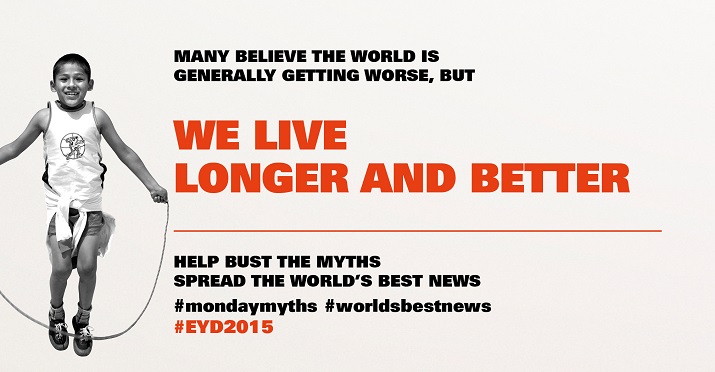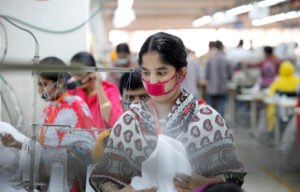
World's Best News
We live longer and better in the world
More than half of the Danish population believes the world has taken a turn for the worse during the last 20 years. However, life expectancy and income is rising the world over while child mortality, hunger, and sickness are down.
Share
The UN measures the world’s progress
The UN Development Program measures the development level of all nations by the so-called Human Development Index, based on a country’s income, life expectancy, and level of education.
Human Development Index is measured on a scale from 0.0 to 1.0. The grade is composite expression of the country’s development level measured on a population’s income, life expectancy and level of education. To attain the highest score, a country’s population needs, on average, to live at least 85 years, earn 75,000 dollars a year and have 15 years of education. In 2013, Norway was the highest-ranking country with a grade of 0.944.
Other categories
In Denmark, 55 percent of the population believes that the world has gotten worse during the last 20 years, according to survey by YouGov. Only a quarter of the Danes think that the world has gotten better.
It’s those in the last quarter who are right though. During the last 20 years, most of the world has undergone enormous and positive changes.
“If you only look at the world’s development in the short-term view, there are always new problems and catastrophes, and the bad stories always hit the front pages. But if you focus on the long-term trends in development, it is clear that the world has gotten better”, says Camilla Brückner, the Director for UNDP’s Nordic Representation Office.
More than a billion people have escaped extreme poverty since 1990. Child mortality has been more than halved for children under five. Five out of every six people the world over can now read and write, and the number is even higher for the world’s youth. The least developed nations earn almost triple of what they did in 1990. Life expectancy has grown worldwide, and for the least developed countries, the increase is almost twice as big as the global average.
The weakest countries have the fastest development
Each year, The UN Development Program measures the development level of the world’s nations (see box).
It is no surprise that Western countries are in the top. However, the poor countries in Eastern Asia and Sub-Saharan Africa move faster up the ladder than the rest of the world. The growth in development is actually 4.6 times faster in the least developed countries than in the most developed nations. This means that the distance between the richest and the poorest countries gets smaller and smaller. Even if you count in the fact that progress is not equally distributed between countries, people and genders, development happens faster in the poorest countries than in the richest.
“Development has never been as fast as during the last 20 years. Living standards and economies are growing fast in the developing countries, and not just in big economies like India and China. Several countries grow faster than expected”, Camilla Brückner explains.
Tangible improvements in quality of life
The progress can seem almost abstract when measured on a UN-index. But the positive development covers tangible progress for millions of people across the world, who live longer and with less hunger, sickness and poverty.
The average life expectancy in the world grew about five years between 1990-2012. In that time, life expectancy in the least developed countries rose about nine years – and in countries as different as the Maldives, Ethiopia, and Cambodia, the people now live as much as 15-17 years longer. Rwanda in eastern Africa is the country with the biggest progress, and Rwandans now live 30 years longer than in 1990. Back then, the average Rwandan was not expected to celebrate his or her 33rd birthday.
At the same time, nine out of every ten children in developing countries attend school, which goes for both girls and boys. Five in six people can now read and write, up from three in four in 1990. This has a big impact on both the positive progress of the world and the individual person’s life.
“The countries with the biggest progress in development are the countries which have invested in health, social security, and education. There is a very clear connection here, which is pivotal to ensure general progress and improvement for people’s individual living standards”, Camilla Brückner explains.
Across the world, people live better. Millions of more people now have enough to eat. The proportion of people living in hunger has been almost halved since 1990. It is estimated that Africa will be able to feed its own population in 15 years.
Many more people survive illnesses like HIV and malaria. The number of new HIV-cases is down almost 40 percent since 2000. In about the same period of time, the spread of antiretroviral therapy against HIV has grown more than 32 times in developing countries. Between 2000-2013, more than six million malaria deaths have been averted thanks to malaria medicine, mosquito nets and by draining breeding grounds for mosquitoes.
Extreme poverty more than halved
Global poverty has dropped massively and many millions of people now have fuller pockets in their daily lives. The share of people living in extreme poverty – surviving on less than 1.25 dollar a day – is down by almost 70 percent since 1990. This means that more than one billion people have escaped extreme poverty and now live better.
Everywhere in the world, the proportion of extremely poor has fallen, but the progress is skewed. China’s explosive economic progress the last decades accounts for a big proportion of the many people who’ve worked their way out of extreme poverty: The number of people living in extreme poverty in China is down 94 percent. On the other hand, the number in Sub-Saharan Africa is down just 28 percent.
However, there’s also good progress in Africa. Since 2000, the continent has experienced some of the biggest economic growth rates in the world, and six countries out of the ten with the highest growth rates between 2000-2010 were African. IMF estimates that growth in Sub-Saharan Africa will drop to 4.4 percent this year – still much higher than the global average on 3.3 percent.
”The share of developing countries in the global economy has grown significantly during the last 20-30 years. A country like Ghana’s share in world trade rises massively for example”, Camilla Brückner says.
In total, the populations in the least developed countries earn almost triple the amount they did in 1990.
Many more children survive
Since the start of the new millennium, there has been a global focus on ensuring that more children will reach their fifth birthday. Luckily, there has been great progress and child mortality is more than halved. This means that more than six million more children survive each year compared to 1990.
The biggest child killers are often easily preventable diseases, such as measles, pneumonia, and diarrhea.
Many believe that it will just increase the population boom and the strain on resources if child mortality drops. But when child mortality goes down, so do birth rates, because fear of losing children to an early death drives up the rates.
In 1970, for example, the average woman in Bangladesh gave birth to seven children, but a quarter of them died before the age of five. Now, the number is down to three births in average, and child mortality is down to seven percent, because the rural population has gotten access to medicine, vaccines, and family planning.
Worldwide, the number of children for every woman has dropped from 3.2 in 1990 to 2.4 in 2011. Thus, assistance to the world’s poorest curbs the population boom.
Peace provides space for progress
Camilla Brückner also points to the fact that a number of wars and conflicts have ended since 1990. This provides space for development in the peaceful countries.
“Quite a few African countries have ended conflicts. This makes space for investments, which can develop the nations. Peace and stability is a precondition for long-term development and improvement of people’s lives”, she explains.
The war in Syria and Iraq is raging on, with hundreds of thousands killed, and millions of refugees. It is a chaotic war which has run for a long time, with inhuman suffering as a consequence and a negative impact on the development of a number of countries.
Worldwide, there is luckily good news. Africa is historically peaceful now, for example. In the late nineties, war claimed the lives of about 95,000 Africans every year. In 2002, the number was down to 15,000.
We can end poverty
From her position in the UN’s Development Program, Camilla Brückner is hopeful on behalf of the world. “One can really be happy for the world’s good progress. It’s become very clear that we can do a lot to improve the lives of many people. Now, the next step is to end poverty completely”, she says.
Camilla Brückner points to the UN’s new Global Goals for Sustainable Development, that all the countries in the world, rich and poor, have agreed upon, with 17 goals for the world’s development towards 2030, including ending poverty.
”The support and backing for this is unique. It is a gigantic united goal, and the work towards it will be chaotic and will happen in jerks and jolts, but it is a giant lever for working people out of poverty”, she concludes.







